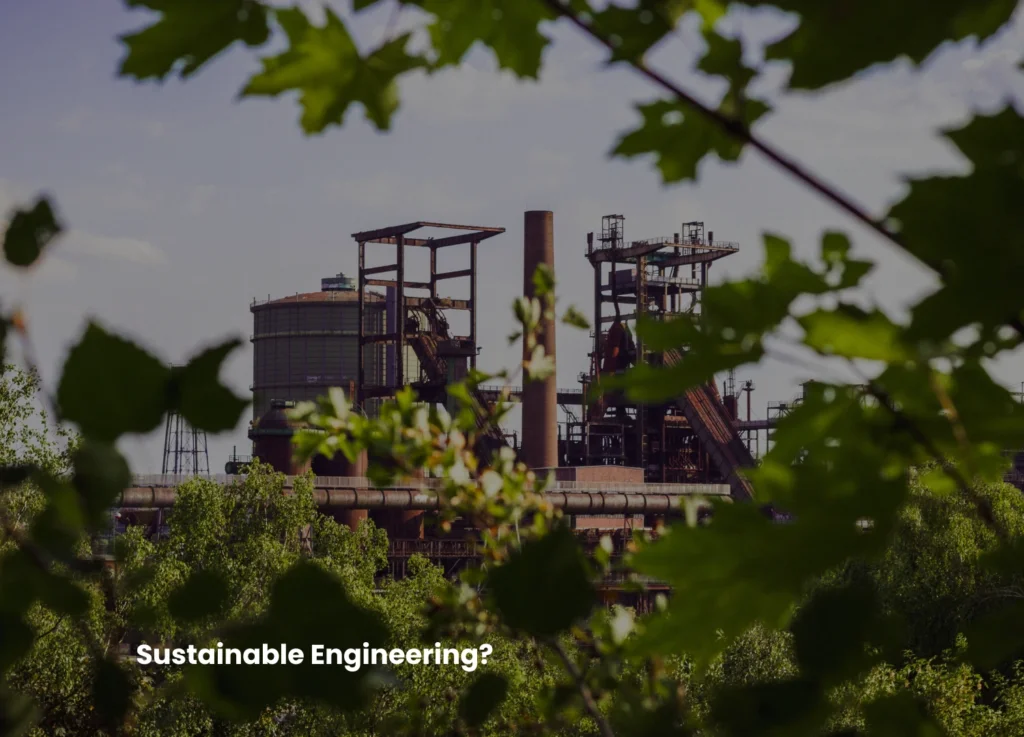As the world continues to grapple with climate change, dwindling natural resources, and increasing urbanization, the need for sustainable solutions has never been more urgent. Engineering plays a pivotal role in shaping the future of sustainability. Engineers are the architects of progress, tasked with developing solutions that not only meet today’s needs but also preserve the world for future generations.
In this blog, we will explore what sustainable engineering is, why it’s important, and how engineers across industries are innovating to do more with less.

What is Sustainable Engineering? 🌱
Sustainable engineering involves designing, developing, and implementing systems that have minimal negative impact on the environment, economy, and society. The core goal is to create long-lasting solutions that are efficient, cost-effective, and environmentally responsible. This approach requires engineers to balance innovation with ecological considerations, ensuring that progress doesn’t come at the cost of the planet’s future.
Sustainable engineering encompasses a wide range of practices, from designing energy-efficient buildings to developing renewable energy systems, recycling waste products, and finding new materials that are both strong and environmentally friendly.
Why Is Sustainable Engineering Important? 🌍
Environmental Impact: The global environmental crisis, driven by pollution, deforestation, and resource depletion, has placed an immense burden on the planet. Engineering solutions that reduce waste, increase energy efficiency, and minimize pollution are essential to mitigating these challenges.
Resource Management: Resources such as water, fossil fuels, and minerals are finite. Engineers are tasked with developing systems that use these resources efficiently or substitute them with renewable alternatives.
Economic Benefits: Sustainability in engineering often leads to cost savings in the long run. Energy-efficient buildings, waste recycling, and renewable energy technologies can reduce operational costs and dependence on expensive, non-renewable resources.
Social Responsibility: Sustainability is also about ensuring that the communities we build can thrive in the future. Engineers must design solutions that promote social equity, protect health, and improve quality of life.
Innovative Sustainable Engineering Practices 🌱
The engineering world has already made significant strides toward sustainability across many fields. Here are just a few examples of how engineers are innovating to do more with less:
1. Green Building Design 🏢
The construction industry is one of the largest contributors to global CO2 emissions. Sustainable engineering practices in building design focus on reducing energy consumption, optimizing resource use, and minimizing environmental impact.
One example is the adoption of green building certifications, such as LEED (Leadership in Energy and Environmental Design). Engineers are now designing buildings with advanced insulation, efficient HVAC (heating, ventilation, and air conditioning) systems, and energy-efficient windows. These buildings are designed to consume less energy, utilize natural light, and reduce the need for artificial lighting and heating.

2. Renewable Energy Systems ⚡
With the global shift towards clean energy, engineers are developing renewable energy solutions like solar, wind, and hydroelectric power. These solutions have the potential to replace traditional fossil fuel-based energy sources, significantly reducing greenhouse gas emissions.
In particular, solar energy has become a leader in sustainable energy solutions. Engineers are working on improving the efficiency of solar panels, making them more affordable and easier to integrate into existing buildings and infrastructure.

3. Circular Economy and Waste Reduction 🔄
In traditional manufacturing, waste is often seen as a byproduct of production. However, sustainable engineering emphasizes the circular economy, where materials and products are reused, recycled, or refurbished to extend their life cycle.
For example, engineers in the automotive industry are exploring ways to design cars that can be easily disassembled for recycling. The closed-loop recycling process is gaining traction, where products like electronics and textiles are continuously recycled and re-manufactured into new products, reducing the need for raw materials.
4. Sustainable Transportation 🚗
Sustainable engineering has also made great strides in the transportation industry. Electric vehicles (EVs) are becoming more common, with engineers working to improve battery technology, reduce charging times, and enhance vehicle range.
Beyond EVs, sustainable infrastructure is also on the rise. Engineers are designing cities with smart transportation systems, optimized traffic flow, and reduced emissions. Public transportation networks are being revamped to be more energy-efficient and reduce reliance on private vehicles.
5. Sustainable Manufacturing ⚙️
Manufacturing processes traditionally have a large environmental footprint, from energy consumption to material waste. Sustainable engineering in manufacturing focuses on creating cleaner, more efficient production methods.
Additive manufacturing (3D printing) is one such innovation that is helping reduce waste. Unlike traditional subtractive methods that cut away material, 3D printing uses only the material needed for the design, minimizing scrap and waste.
Additionally, engineers are exploring bio-based materials (like bioplastics) and sustainable production techniques that reduce carbon footprints and energy usage.
Challenges to Sustainable Engineering 🌍
Despite the many advancements in sustainable engineering, several challenges remain:
High Initial Costs: Sustainable technologies often have high upfront costs, which can deter businesses from adopting them. However, the long-term benefits—such as reduced energy bills, lower maintenance costs, and potential regulatory incentives—can make these investments worthwhile.
Resistance to Change: Many industries and individuals are resistant to adopting new technologies or practices, especially when traditional methods have worked for years. Overcoming this resistance requires not just technological advancements but also changes in mindset and cultural attitudes toward sustainability.
Limited Resources for Research and Development: Although sustainability is a growing focus, there’s still a need for more investment in research and development (R&D). Engineers need access to cutting-edge technologies and funding to create innovative, sustainable solutions at scale.
The Future of Sustainable Engineering 🌱
The future of sustainable engineering holds incredible potential. As awareness grows about climate change and environmental degradation, governments, industries, and consumers are increasingly demanding more sustainable products and services.
In the next decade, we can expect:
Smarter cities with advanced infrastructure and technology that promote sustainability and efficiency.
Clean energy becoming more affordable and accessible, leading to reduced reliance on fossil fuels.
Zero-waste systems that eliminate the concept of waste by reusing, recycling, and upcycling materials.
Greener manufacturing processes powered by renewable energy and resource-efficient production techniques.
Sustainability will no longer be an afterthought in engineering—it will be a fundamental principle in every project and design.

Conclusion: A Better World Through Engineering 🌎
Sustainable engineering is a vital part of the future of both our planet and its people. Engineers play a critical role in ensuring that future generations inherit a world that is both livable and thriving. By using innovative technologies and adopting sustainable practices, engineers can help create a future where we do more with less.
At KEYWAY, we believe that sustainable engineering is not just an option; it’s an imperative. As we look to the future, we remain committed to developing solutions that meet the needs of today without compromising the needs of tomorrow.
#Sustainability #Engineering #Innovation #GreenEngineering #FutureOfEngineering











